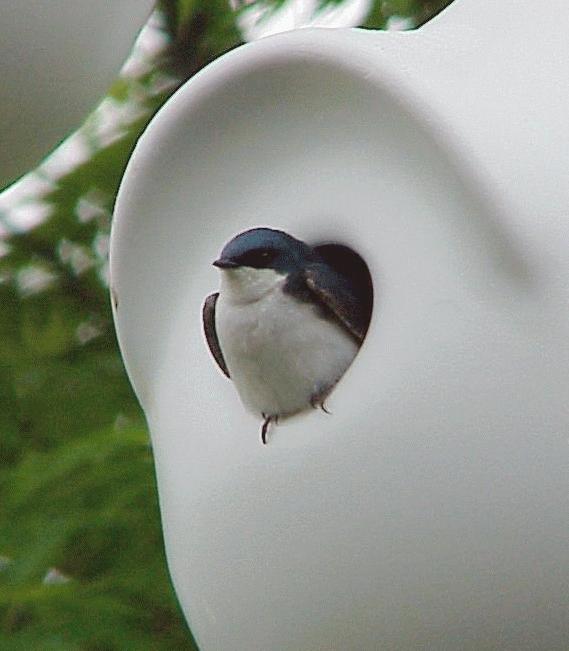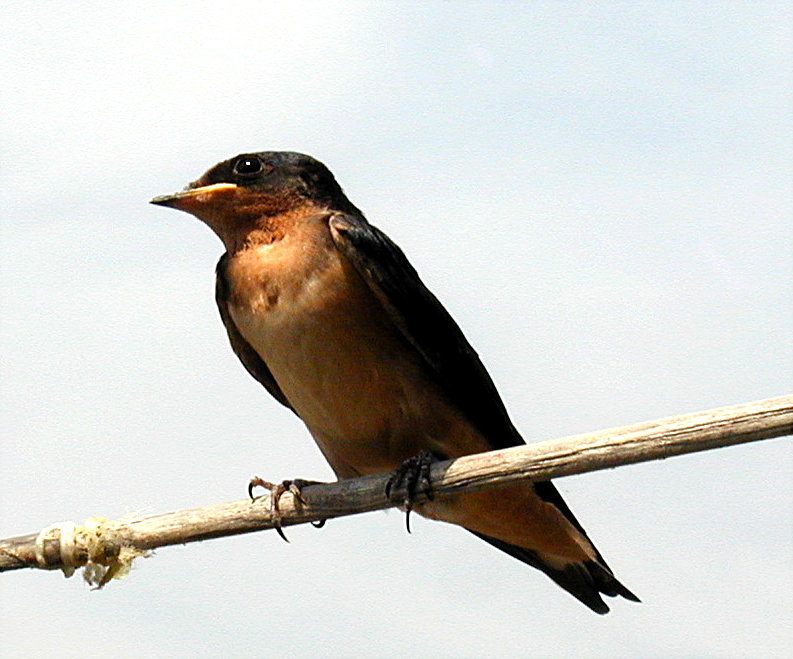
Along with the Starlings and Sparrows, there are other birds that compete with
purple martins for nesting cavities. We've discussed the
two trash birds and what can be done to eliminate them, but now we have to discuss the
good birds, or birds that are native to America that cannot and should not
be destroyed or harmed in any way. Instead, other measures need to be incorporated to remove them from the martin housing. They
too, are friendly to us humans and can also be a treat to have around if properly cared for. They are
in your martin housing because they are looking for a place to raise their young and if the time is taken to properly supply them housing, they can be enjoyed right along with the martins. The following are a few of the major competitors that you may run into and what can be done to keep them from your martin house.
In fact, even if you don't have martins but would like to supply housing for them, then this page will help with that.

Tree Swallows are found throughout much of the northern part of the purple martin's range, down to about the Tennessee/Alabama line and westward. Tree swallows are a cousin of the martin and are about the size of a bluebird. They also seek out man-made housing in which to build their nests and although a member of the swallow family they don't congregate in large close knit colonies. Their habits are more like the bluebird in that they feed much closer to the ground, prefer individual nest boxes, and like to spread out a little more. They're very territorial towards other birds of their own kind, (other tree swallows and martins) and will vigorously defend their nests against other TS's (or martins) that may invade their home space.
Surprisingly, they will live side by side with bluebirds, thus pairs of boxes can be supplied for them. The two boxes can be as close as 20 feet to each other, although 30 to 50 is better. TS will take one box and BB's will take the other and get along just fine
As can be seen by the picture, they are a beautiful little bird and, as stated, will readily use housing that is supplied by man. It is not unheard of to have a martin colony and tree swallow
nest within close proximity of each other and as long as they each have their own space, then all will get along just fine.
However; if tree swallows are allowed to begin a nest in NEW martin housing, then this
can create a problem. They will attempt to drive any martins away from the
housing and will do what ever it takes to keep them away, thus; it is not good
to let them get fully established in your martin housing.
So, what do you do to keep tree swallows out of your martin housing?
Easy! You move them, it's that simple.
The link I give below goes into detail on exactly what it takes to move Tree
Swallows away from martin housing.
Link to a photo of an Eastern Bluebird
The Eastern Bluebird is another competitor that just about every martin landlord will run into.
To the best of my knowledge, they nest in just about every place that martins
nest. Again, these are another beautiful and friendly little bird that is a joy to have around. Their unique call quickly distinguishes them from the other birds in the area. Again,
if you are trying to attract martins, then they should not be allowed to nest in
the martin housing and removing them employs the same method used for the tree swallows.
Although they don't use feathers in their nests, putting some individual housing up for them
and then adding just a little soft grass usually gets their attention,
especially if they can't get back into their original martin house.
As before, close up the martin house for a couple two or three days or at least until they start building a nest and then
once their nest is started in their new box, re-open the martin house. Again, once
committed to the new nest box and nest, they will not abandon it for the martin
colony.
Link to photo of a Black Capped Chickadee
Link to photo of a Carolina Chickadee
Two lesser competitors, the Black Capped and Carolina Chickadee will quickly move to housing supplied as described above.
Yes, they will use BB boxes, but you might want to consider a box made more to
their size with the smaller 4 x 4 inch compartment floor and 1 inch entrance
hole. If BB boxes are used, house sparrows or other birds will take it
from them. They usually like the lower housing rather than the high martin houses, but
if nothing else is available, they will take what they can get which is why they
are in your martin housing. If we take time to remember them and supply them some housing, they are just one more treat in the bird world that are enjoyable to have around.
These little beauties are very friendly towards man and you'll find that they
may not even get off their nests when you check inside.
Link to photo of a Greater Crested Flycatcher
Again, to a much lesser degree, these birds can occasionally be found in martin housing and the same rules and methods apply to moving them to their own housing. Try to keep them away from the human housing a little. Although they will use our
supplied housing, they don't like our company quite as much as the martins, so
you may want to move it as far away as possible so they have their privacy.

Although these birds are not housing competitors, they are often mistaken for martins. These
are the birds that will nest up under your porch eaves if they can. It's covered from the elements and there are humans close by to keep the major competitors away. They are great for breaking the young into bird watching since they are right on your front porch.
Some folks don't like the mess, but if a piece of plywood or cardboard is set up below the nest, this usually catches all the mess from the young and it can be discarded after the young have left. If comfortable from raising the first brood, they will often raise a second brood using the same nest.
Here's a Little Tip...
I designed a little bracket specifically for mounting BB boxes to T-shaped fence posts. It can be purchased from S&K Manufacturing out of O'Fallon, Missouri. Once there, look in the Bluebird Section and you can look around. There are a number of different choices for housing and maybe one will fit your needs. Or if you already have your own housing and would like to order the T-Post Mount bracket alone (TPM), then they have them. They are rather inexpensive, so you might want to consider getting a couple... just in case...
I presently have a BB trial along the road that I live on that is 1 1/2 miles long and has 36 boxes (both wood and plastic) on it. Just about every box is mounted to a T-post using one of these little TPM brackets. Very easy to install and they work beautifully. If the boxes are near livestock (cows and horses), you might want to add a couple of hose clamps, one above and one below the bracket so that the livestock can't dislodge or upset the box. It also helps prevent the box from being 'lifted' off the post and taken to someone else's back yard.